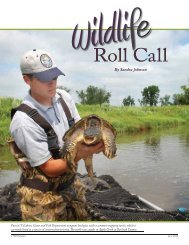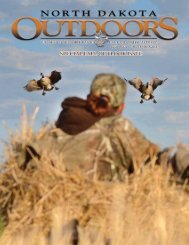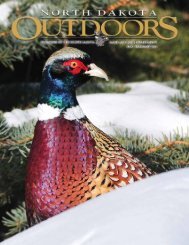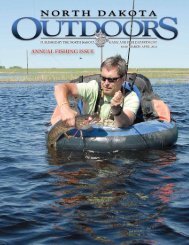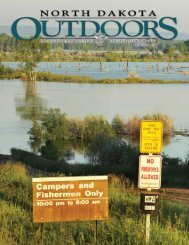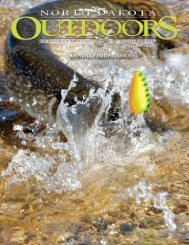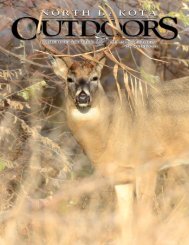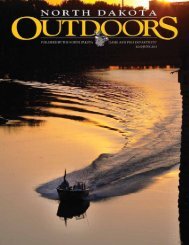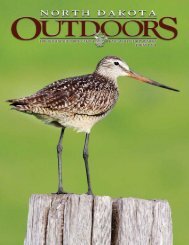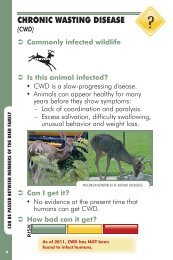March_April 2013.pdf - North Dakota Game and Fish
March_April 2013.pdf - North Dakota Game and Fish
March_April 2013.pdf - North Dakota Game and Fish
- No tags were found...
You also want an ePaper? Increase the reach of your titles
YUMPU automatically turns print PDFs into web optimized ePapers that Google loves.
Typically, the view through a crystal ball isnot obvious when making long-term predictions.However, in the case of forecasting fishing opportunitiesin <strong>North</strong> <strong>Dakota</strong> for 2013, the view ispretty clear, with a favorable outlook for anglers.Although a few water bodies may have slowerfishing than what many have experienced in recentyears, most anglers should have another good toexcellent year in 2013.Why such optimism? Well, we need to first lookback to underst<strong>and</strong> what to expect in the future.For so many events in life, there’s usually a lagbetween actions <strong>and</strong> consequences. Parents heavilyinvest their time into their children in hopes thatas young adults they make mature decisions. Societyparticipates in educating our youth, anticipatingsomeday they will become civic leaders, entrepreneurs<strong>and</strong> so on. This cause <strong>and</strong> effect dynamicis also true for today’s fishing opportunities.<strong>Fish</strong>ing-related events <strong>and</strong> actions that occurredin the past are often observed today in both opportunity<strong>and</strong> success. To that end, I’d like to share ashort list of management decisions/actions madeby the <strong>North</strong> <strong>Dakota</strong> <strong>Game</strong> <strong>and</strong> <strong>Fish</strong> Departmentthat are contributing to today’s good fishing.However, before sharing these dozen or sosuccess stories, it is imperative to recognize thatMother Nature has been extremely kind to bothfish <strong>and</strong> angler in the past 20 years. Most notably,the unprecedented wet conditions between 1993<strong>and</strong> 2011 that resulted in today’s record numberof 400 or so managed water bodies. That’s morethan double the number of managed waters <strong>North</strong><strong>Dakota</strong> had in the late 1980s. Runoff has filledsloughs <strong>and</strong> meadows, creating phenomenal newfisheries through much of central <strong>and</strong> eastern<strong>North</strong> <strong>Dakota</strong>.Regardless of all the new water on the l<strong>and</strong>scape,anglers fishing <strong>North</strong> <strong>Dakota</strong>’s waters alsobenefit from past management decisions, actions,<strong>and</strong> in some cases, nonaction. Whether someonecaught a 10-pound walleye from Lake Sakakaweain the mid-1980s, a 2-pound yellow perch fromDevils Lake in 2012, a rainbow trout anywhere in<strong>North</strong> <strong>Dakota</strong>, a chinook salmon from GarrisonDam Tailrace, a walleye from any of the state’snearly 150 walleye lakes, or simply went fishing intheir boat on one of 265 lakes with public ramps,a number of past l<strong>and</strong>mark events helped shapethese opportunities. Looking through the rearviewmirror, these activities, some dating back 40-plusyears, are briefly highlighted:• Despite being the largest water body inthe state, forage was sorely lacking in LakeSakakawea after it filled in the 1960s. Theintroduction of rainbow smelt in 1972 ultimatelyprovided a strong forage base <strong>and</strong> is/was responsible for the large predator fish(walleye, northern pike <strong>and</strong> chinook salmon)in the Missouri River System.• In 1986, a new coldwater production facilitywas completed at the Garrison Dam National<strong>Fish</strong> Hatchery, enabling the <strong>Game</strong> <strong>and</strong> <strong>Fish</strong>Department to annually stock quality-sizedchinook salmon into Lake Sakakawea <strong>and</strong>Garrison Tailrace. Further, the coldwaterbuilding annually produces up to 80,000catchable-sized trout, mainly rainbows, thatare stocked annually into approximately 50waters statewide, including the Tailrace.• During the early to mid-1980s, the Departmentevaluated a walleye fingerling stockingapproach that proved successful for LakeSakakawea. This information helped supportthe need for additional rearing ponds, <strong>and</strong>eventually walleye stocking strategies wereapplied successfully for all of the state’s waterbodies, including Sakakawea <strong>and</strong> Devils Lake.• With an obvious need to supplement LakeSakakawea’s walleye population, <strong>and</strong> anongoing call to stock more fingerlings intodistrict lakes, the number of rearing ponds atGarrison Dam National <strong>Fish</strong> Hatchery wasexp<strong>and</strong>ed from 24 to 64 in 1989. Since then,<strong>North</strong> <strong>Dakota</strong> has led the nation most yearsin stocking walleye <strong>and</strong> northern pike fingerlings.Both pond expansion <strong>and</strong> the coldwaterfacility would not have been possible withoutthe unique <strong>and</strong> strong partnership betweenthe Department <strong>and</strong> the U.S. <strong>Fish</strong> <strong>and</strong> WildlifeService.• In 1986, with an influx of more Sport <strong>Fish</strong>Restoration funds, the Department costsharedfor the first poured concrete boat rampin the state <strong>and</strong> subsequently has been able toadequately fund a development program thatmeets the state’s public boating infrastructureneeds. Ramps, docks, toilets, roads <strong>and</strong> fishcleaning stations are now part of the normalroutine.• An unglamorous, but critically importantinitiative was tackled beginning in the early1990s, addressing bait bucket transfer ofunwanted fish throughout the state. An<strong>March</strong>-<strong>April</strong> 2013 ND Outdoors 3



